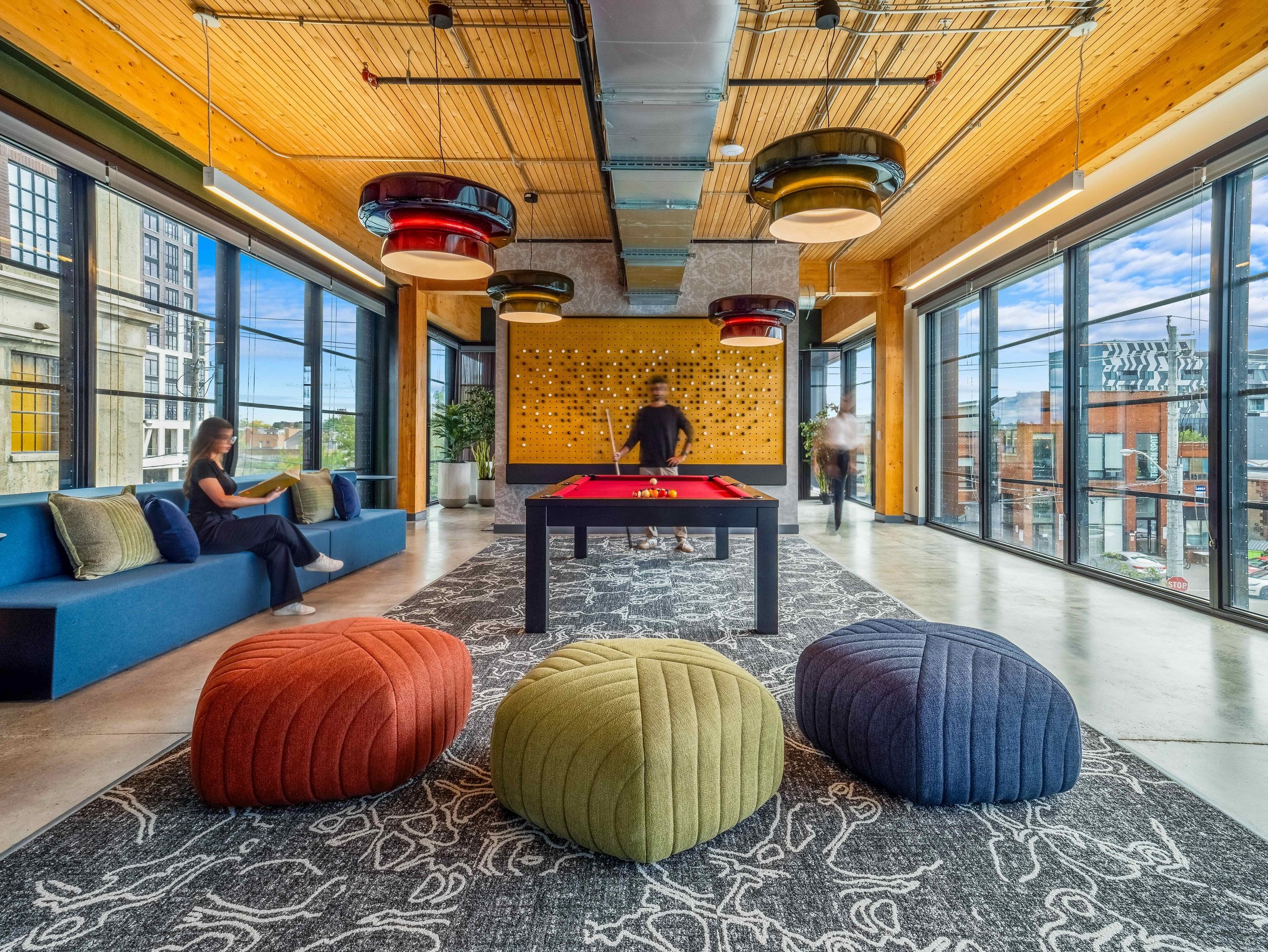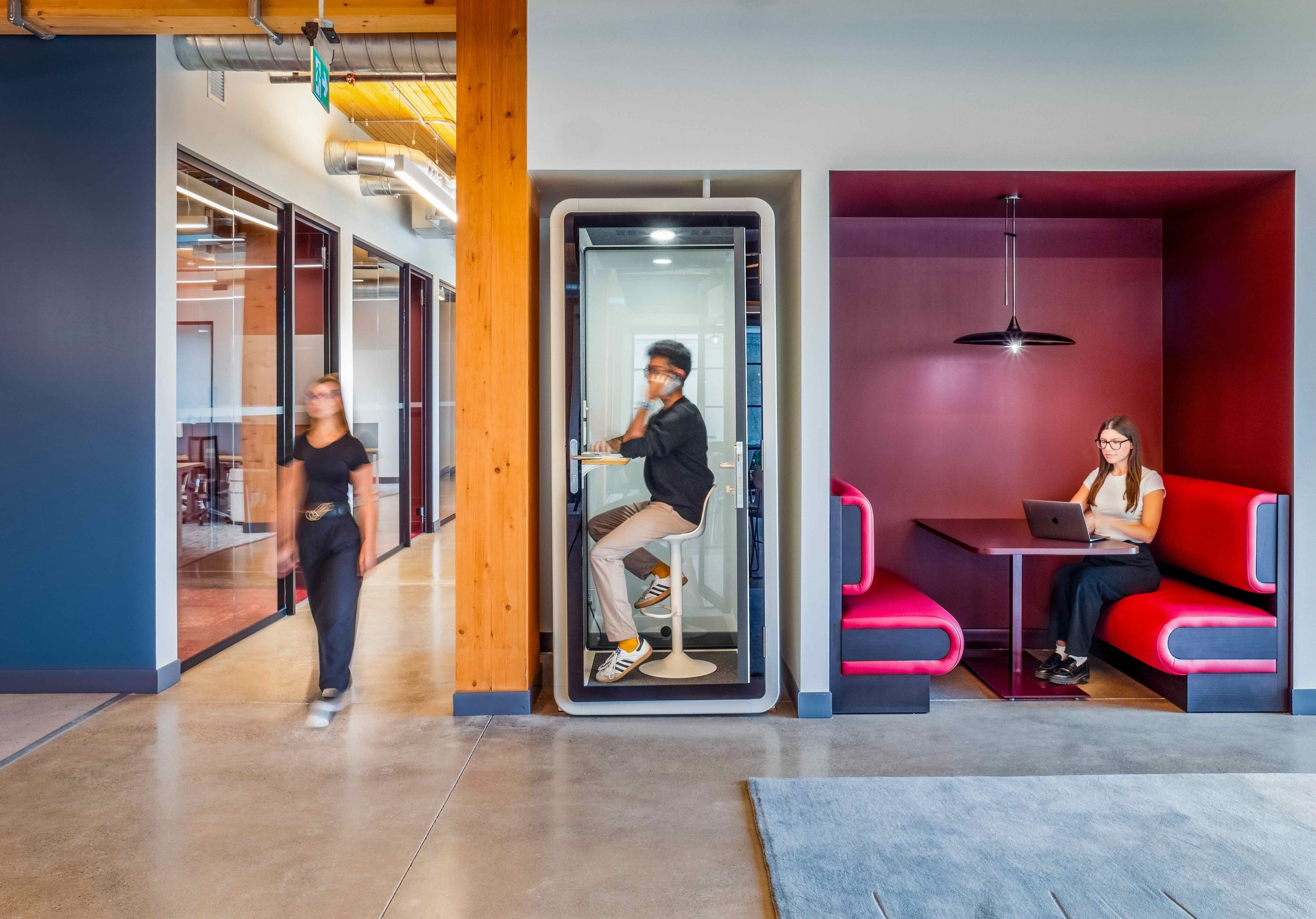What Matters in Workplace Design: Creating Spaces That Work
Table of Contents:
Design for Flexibility
Comfort and a Human Touch
Quiet Spaces for Focus
Designing Spaces That Work for People
According to Andrew Naber, an industrial-organizational psychologist, the average person will spend a third of their lives at work. That’s a lot of time driving performance and innovation across the company—and, let’s be honest, impatiently waiting for the microwave.
At Clearspace, we design offices that inspire productivity, connection, and well-being.
Today’s best offices aren’t just spaces to sit; they’re built for how people actually work. It’s time to reevaluate what matters most for workplace design. Here’s how we make that happen.
1. Design for Flexibility
Work looks different every day. Some days, the office is busy and full of energy. Other days, it’s quieter. Just like the office shifts, so do the ways people work. Some days, they’re learning, socializing, or coming in to collaborate with their team. Other days, they’re working remotely.
Before, offices were designed around density—more desks, more people, more bodies in a room. Now, we know a great workplace is about how well it supports the people using it. More than ever, employees are using spaces differently.
Flexibility and choice are at the core of design, the lines between traditional desking and adjacencies are blurring. Workplaces are now adaptable kits-of-parts, where anything from furniture to fixtures can be flipped, moved, or reused to meet employees' flexible needs.
Flexible spaces should also cater to personal preferences, offering a variety of work settings—including more intimate alternatives to the open-plan office. Not everyone thrives in large, shared environments, so creating spaces that support both collaboration and quiet work is essential for a well-balanced, high-performing workplace.
What makes a difference:
✔ Meeting rooms designed for virtual collaboration – High-quality video conferencing, adjustable lighting, and acoustic treatments for hybrid meetings.
✔ Hot desking and touchdown spaces for remote workers – App-based desk booking systems and ergonomic sit-stand desks for seamless workspace reservations.
✔ Interactive whiteboards and digital tools – Smartboards and wireless collaboration tools for real-time brainstorming.
✔ Adaptable seating for focused work and team huddles – Lightweight, mobile chairs and modular lounge seating that transition between solo tasks and group discussions.
✔ Modular furniture and flexible layouts – Rolling partition walls, reconfigurable desks, and movable whiteboards to instantly reshape workspaces.
✔ Smaller, private workspaces for heads-down focus – Soundproof pods, enclosed nooks, and high-backed seating for quiet, distraction-free work.
2. Comfort and a Human Touch
At Clearspace, we know that workplaces that prioritize human experience will be the ones employees value most. A well-designed office isn’t just about productivity—it’s about creating spaces where people feel comfortable engaging with one another.
When employees feel at ease in their environment, they’re more likely to collaborate naturally, mentor others, and build meaningful relationships. A thoughtfully designed space—one that balances warmth, functionality, and social connection—makes it easier for people to read body language, exchange ideas freely, and create moments of trust and camaraderie.
By incorporating comfortable collaboration zones, casual meeting spaces, and recharge areas, offices encourage a human touch, spontaneous conversations and deeper team connections. These human moments are what truly make a workplace thrive.
What makes a difference:
✔ Lounge-style collaboration spaces that feel less like boardrooms and more like living rooms – Instead of rigid conference rooms, incorporate softer, informal settings with comfortable seating, coffee tables, and warm lighting to encourage organic, creative discussions.
✔ Soft, natural lighting that keeps energy levels up throughout the day – Offices are designed around natural light by placing meeting rooms and enclosed offices toward the interior while workstations and open areas stay near windows. This mimics circadian rhythms, reducing fatigue and improving focus.
✔ Recharge zones for quick breaks and stress relief – Dedicated spaces with comfortable lounge chairs, noise-canceling areas, and even nap pods allow employees to take a moment to reset. These areas encourage mental recovery, leading to higher productivity and focus.
✔ A mix of quiet and social spaces – Employees now have options: from cozy nooks with soft chairs for solo work to café-style gathering spaces with music and casual seating for informal meetings. This balance support people working in a way that suits them best at any given moment.
3. Quiet Spaces for Focus
Open offices are great for connection, but they don’t always support deep work. When employees need to focus, think, or take calls without distractions, the right environment makes all the difference. Noise can be a productivity killer.Excessive noise can lead to decreased concentration, increased stress, and lower job satisfaction.
The modern workplace is undergoing a quiet revolution, where acoustics play a crucial role in shaping how people experience their environment. Offices are moving beyond the old open-plan approach and integrating strategic zoning—balancing quiet zones, collaborative spaces, and social areas based not just on layout, but on sound profiles.
Smart offices are also embracing sound masking technology without eliminating the lively energy of an office. Materials like recycled fabric panels, eco-friendly foam, and living walls are also transforming modern workplaces, absorbing noise while enhancing the overall aesthetic and sustainability of the space.
A well-balanced acoustic environment is about creating a healthier, more focused, and more productive workplace. The future of office design is one where every decibel counts, and where silence is essential.
What makes a difference:
✔ Acoustic wall panels and sound masking – Fabric-wrapped panels, eco-friendly foam, and white noise systems reduce unwanted sound.
✔ Framed doors with acoustic seals – Double-layered glazing and magnetic seals minimize sound transfer between rooms.
✔ Carpeting in high-traffic areas – Carpet tiles, cork flooring, and underlays absorb foot traffic noise.
✔ Zoning spaces based on sound profiles – Quiet zones, social hubs, and collaboration areas to create the right space for the right work.
People are repulsed by a the idea of coming to a stale, corporate workplace (cubicles and white lights). They want identity. A workplace is a living reflection of a company’s values, identity, and culture. When an office is thoughtfully designed to align with a company’s brand and mission, it fosters a deeper sense of belonging among employees.
Leading organizations are recognizing the power of local influences in workplace design. Offices that incorporate elements from their city, region, or cultural history create a sense of pride and connection among employees. Whether through architectural details, materials, or artwork, these elements help make the workplace feel authentic and rooted in its surroundings.
Beyond aesthetics, design choices shape company culture. From collaborative layouts that encourage teamwork to quiet zones that support focus work, every element of the workplace influences how employees engage, connect, and thrive. A strong workplace identity also extends beyond the physical space, reinforcing shared values and a collective vision for the future.
What Makes a Difference:
✔ Brand embodied in design – Offices should visually reflect company values through colours, materials, and artwork.
✔ Preserving unique architectural details – Keeping original features, textures, and materials maintains authenticity and character.
✔ Murals and artwork – Spaces feel more personal with locally inspired art and company storytelling.
✔ A sense of place – Offices that incorporate local history, city influences, or cultural elements foster deeper community ties.
4. Designing Spaces That Work for People
At Clearspace we believe the best workplaces do more than serve a function—they create an experience. A well-designed office adapts to different work styles, offering quiet spaces for deep focus, open areas for collaboration, and design elements that reinforce company culture. When people feel comfortable, inspired, and connected to their environment, they thrive. Productivity flows more naturally, teamwork becomes effortless, and creativity flourishes. Thoughtful design isn’t just about aesthetics; it’s about elevating the way people work, interact, and innovate.





